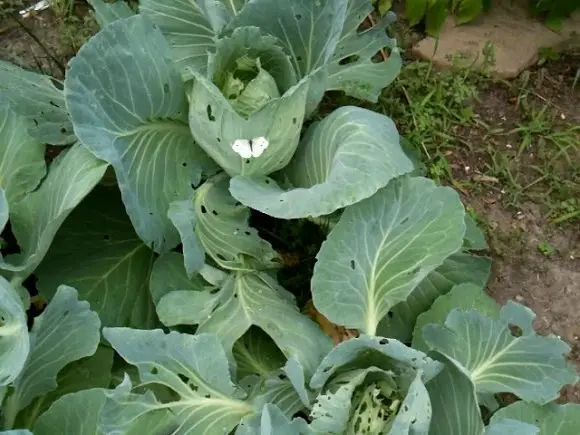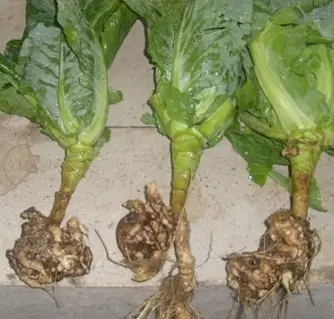Contents
Usually summer residents prefer cabbage varieties with high yields and disease resistance. Of considerable importance is unpretentiousness in care. Few varieties of cultivated plants have such characteristics, and among them is Sugarloaf cabbage. In addition, it has become popular due to its resistance to drought.
Description of cabbage Sugarloaf
This variety belongs to the late-ripening group. On average, it fully matures in 3 months. The rosette of cabbage is powerful, grows slightly spreading, the diameter reaches 80 cm. The leaves of the culture are large, their shape is round, slightly wavy at the edges. The color of the Sugarloaf is usually green, but there is a bluish coating. A photo of cabbage Sugarloaf is presented below.

The head of the Sugarloaf variety is large and dense
Heads of cabbage grow beautiful and even, have a spherical shape. The mass of an ordinary head of cabbage is about 3 kg, but sometimes large specimens are found. After harvesting, the heads of cabbage still ripen for one to two months. Then they are already eaten, because by that time they acquire a sweetish pleasant taste.
Advantages and disadvantages
According to summer residents, the advantages of the Sugar Loaf cabbage variety include:
- high level of sweetness (much higher than other known varieties);
- lack of hard veins;
- the presence in the composition of many vitamins, trace elements;
- long shelf life, during which all nutritional qualities are preserved;
- resistance to prolonged drought;
- excellent germination of material for sowing;
- resistance to diseases and pests.
The most significant disadvantages of cabbage Sugarloaf are:
- exactingness to change the sowing area;
- the need for good lighting (can not be planted in shaded areas).
The considerable popularity of the Sugar Loaf is dictated by the obvious predominance of advantages over disadvantages.
Cabbage yield Sugar loaf
This variety gives a fairly high yield, reaching 6 kg per 1 m2 of plantations. The weight of an ordinary head of cabbage is approximately 3 kg. The latter is characterized by high density.
Planting and caring for cabbage Sugarloaf
It is recommended to grow a variety using seedlings. Her training begins in April. Seed material needs separate pre-sowing procedures. It is left for 12 hours in a solution of potassium permanganate, then washed with water, dried.
Land for a future landing can be prepared on their own. For this purpose, turf, peat, sand are mixed in equal proportions. Peat pots are perfect as dishes for plants.
Pots should be placed in a lighted place without drafts, direct sunlight. The temperature regime in the room should be within 21-25 ° C.

Seedlings are planted in fertilized soil
At the beginning of summer, after the appearance of four leaves, cabbage seedlings Sugarloaf are planted on beds in prepared soil. Ash solution is used as a fertilizer. The site is chosen with good lighting.
During growth, the culture needs to be fed. To do this, use an aqueous solution of manure. It is used 2 times.
The root system is strengthened as a result of hilling the bushes, which is carried out under the condition that 10-12 sheets are formed. This procedure will additionally help form lateral roots.
Watering is performed 1-2 times for 3 weeks. During the formation of heads, the need for water increases.

Watering the cabbage is done as the earth dries out.
Caring for the Sugarloaf also includes periodic loosening of the soil near the plants, timely removal of weeds.
Diseases and pests
Cabbage Sugarloaf is resistant to diseases, but still, insufficient plant care can provoke the occurrence of some diseases. Among the most common are the following:
- Bacteriosis. There is a yellowing of the extreme parts of the leaves with further darkening and falling off. To prevent such a disease, high-quality seed is used, the necessary crop rotation is observed, and preventive measures are made with Fitolavin. With an infection that has already occurred, the Planriza remedy will help.

- Powdery mildew downy. A white coating appears on the surface of the leaves. As a preventive measure: on the eve of sowing, the seeds are kept in warm water for 25 minutes, the plants are healed with ammonium nitrate. When the disease spreads, spraying with a solution of copper sulfate helps.

- Cabbage butterfly. Infected leaves turn pale, and plants die over time. Sowing dill, parsley near the cabbage patch significantly reduces the likelihood of the spread of the disease.

- Fuzarioz. When infected, yellow spots appear on the leaves. In order to prevent the disease, it is recommended to treat the culture with copper sulphate or a special agent “Agate”. Affected plants should be immediately removed from the garden.

- pounds. Occurs when a pathogenic fungus appears. Subsequently, the growth of the culture slows down or stops, sometimes the plants die. Liming the soil, observing the correct crop rotation, and treating with potassium permanganate on the eve of planting will help prevent the spread of the fungus. Infected specimens of cabbage must be destroyed.

The most dangerous pests for cabbage Sugarloaf:
- aphid. Usually sticks to the sheets from the back. High activity of aphids is observed at the end of the summer period and throughout the autumn.
- Cruciferous bugs. Spread over the surface of cabbage leaves, feed on its juices.
- TRIPS. They cannot be seen with the naked eye. In the case of charging, the plant loses color and soon dies.
Effective pest control products:
- “Iskra M”;

- “Fury”;

- “Bancol”.

They are also used for spraying the ground around plants.
Application

Cabbage dishes have a pleasant taste
Since this variety has good taste qualities, contains more nutrients than other types, it is often used for everyday cooking, pickling. Such cabbage is well preserved, which significantly extends the period of its fresh use for cooking.
Storing Cabbage Sugar Loaf
All top sheets are removed from the heads of the harvested crop, and then dried. It is impossible to keep the crop wet, in such conditions it will quickly rot. Be sure to inspect the cabbage coils for any damage. Slightly damaged copies are stored in a separate box. The rest of the cabbage is sorted.
The place for storing the crop should be dry, darkened, equipped with a ventilation system. Suitable storage temperature is from -1 C° to +4 C°, permissible humidity is 90-95%. Under the necessary conditions, cabbage Sugarloaf does not deteriorate until spring, does not lose its taste.
Conclusion
White cabbage Sugarloaf belongs to varieties with late ripening. She is completely undemanding in care, has good immunity to dangerous diseases. This healthy and tasty product is suitable for regular consumption, as it contains a lot of nutrients that are beneficial to the body. They keep well even for a long time.

















